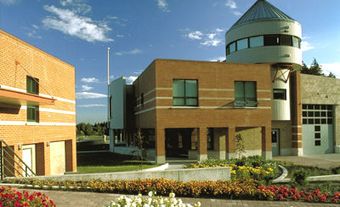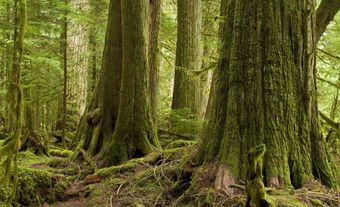North Vancouver, British Columbia, incorporated as a district in 1891, population 85,935 (2016 census), 84,412 (2011 census); also, a separate entity incorporated as a city in 1907, population 52,898 (2016 census), 48,196 (2011 census). The district of North Vancouver and the city of North Vancouver are located in southwestern British Columbia, adjacent to the city of Vancouver. Situated on the north shore of Burrard Inlet, North Vancouver extends from the Capilano River on the west to beyond Deep Cove on the east. The district surrounds the city, which is centered on Lonsdale Avenue, except at the waterfront. Elevations in North Vancouver range from sea level to 1,400 metres. The North Shore mountains — such as Grouse and Seymour — form a scenic backdrop.
Settlement
North Vancouver is on the traditional territory of several Coast Salish peoples: the Squamish, Tsleil-Waututh and Musqueam nations. Burrard Inlet was an important source of fish, shellfish, seaweed and plants for these peoples.
The first Europeans in Burrard Inlet were Spanish explorers and an English party led by George Vancouver in the early 1790s. The first encounters between Europeans and Coast Salish peoples occurred during these explorations.
During the 19th century, the Hudson’s Bay Company supplied the fur trade with pelts harvested across British Columbia, including the Lower Mainland area that now contains North Vancouver. Epidemics of smallpox devastated Indigenous populations, which did not have immunity to the foreign disease.
The rich forests on the north shore of Burrard Inlet drew the first settlers to the area. In 1862, T.W. Graham and George Scrimgeour acquired a 194-hectare timber stand in what is now North Vancouver. Timber was soon shipped from the quickly erected Pioneer Mills. (See also Timber Trade History.)
Development
A small waterfront sawmill town developed into the largest settlement on the inlet. An American, Sewell P. Moody, bought the former Pioneer Mills in 1865. By the early 1870s, the settlement was called Moodyville. In 1891, five years after Vancouver incorporated as a city, the north shore became the District of North Vancouver. The Second Narrows Bridge, completed in 1925, provided a fixed rail and vehicle link with Vancouver. The Lions Gate Bridge, completed in 1938, provided a second link (see Lions Gate Bridge Opens to Traffic). The Second Narrows Bridge was rebuilt in 1960 and later renamed the Ironworkers Memorial Bridge to commemorate a construction accident that took 19 lives in 1958. The extension of the Pacific Great Eastern Railway (now part of Canadian National’s network) from Squamish in the 1950s increased North Vancouver’s importance as a transshipment point.

Economy
North Vancouver is an important shipping port for lumber, ore and grain. Its shipyards were a central part of the Canadian economy for most of the 20th century. The Burrard Dry Dock Company — later named Burrard Yarrows and finally Versatile Pacific Shipyards — was one of the largest shipyards in Canada. In 1928, it built the RCMP schooner St. Roch, which is on display at the Vancouver Maritime Museum. Following the 1992 closing of Versatile Shipyards, the eastern portion of the site continued to operate as the Vancouver Drydock Company. The western portion of the site remained neglected for years. In 2004, the federal government recognized shipbuilding at the Burrard Dry Dock Company as a national historic event. Redevelopment projects have since revitalized the western part of the site with mixed residential, leisure and commercial space.

Photo taken 17 January 2016.
Today, shipbuilding continues on North Vancouver’s waterfront at Vancouver Shipyards, a major employer in the city. The Insurance Corporation of British Columbia, headquartered in North Vancouver, is another large employer.
North Vancouver is home to several film studios, and it is a popular setting for film and TV shoots. Film permits are a significant source of revenue for the city and the district.
Government
The district and the city are each governed by a mayor and six councillors.
Tourism
North Vancouver’s outdoor attractions include facilities for fishing, sailing, skiing and mountain climbing in the area’s many parks. Next to Capilano River Regional Park, the famous Capilano Suspension Bridge, 70 m above the river, stretches 137 m across the canyon. Cleveland Dam, north of the park, releases fresh drinking water for the Greater Vancouver area from Capilano Lake. In the eastern part of the district is Mount Seymour Provincial Park. In the north are Lynn Headwaters Regional Park and Lower Seymour Conservation Reserve.
Other tourist attractions include Lonsdale Quay Market, Grouse Mountain Skyride, Capilano Salmon Hatchery, Capilano University, the North Vancouver Museum and Archives, and The Polygon, a gallery of contemporary art.


 Share on Facebook
Share on Facebook Share on X
Share on X Share by Email
Share by Email Share on Google Classroom
Share on Google Classroom


